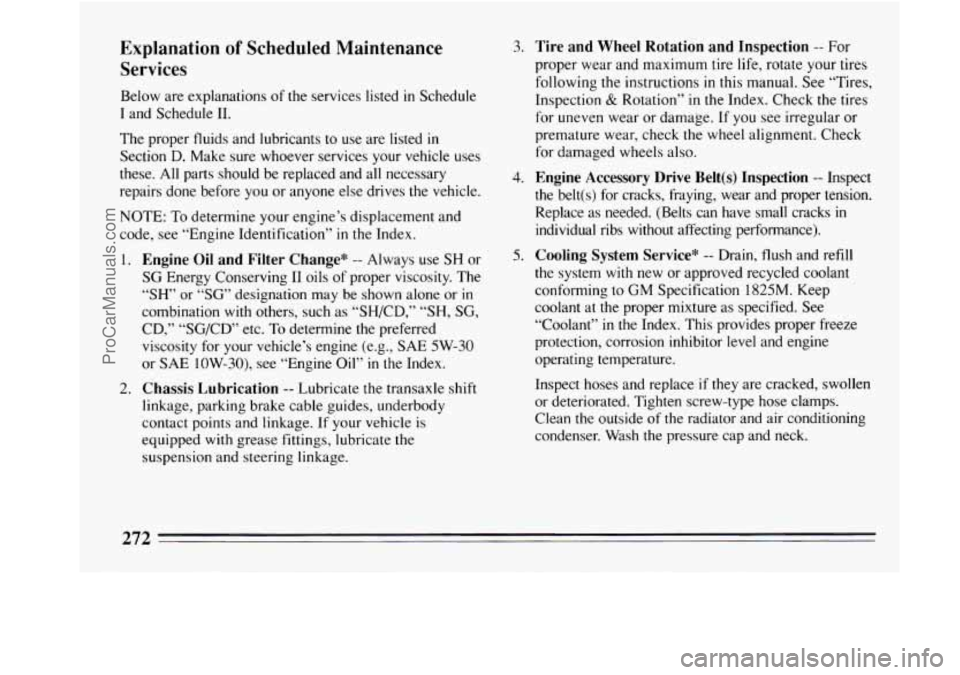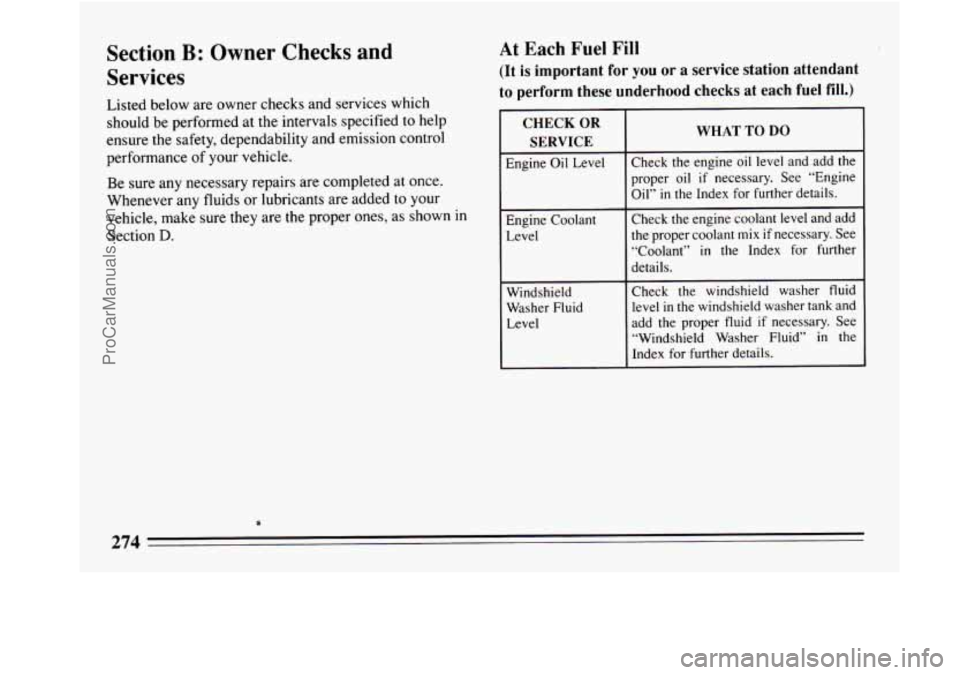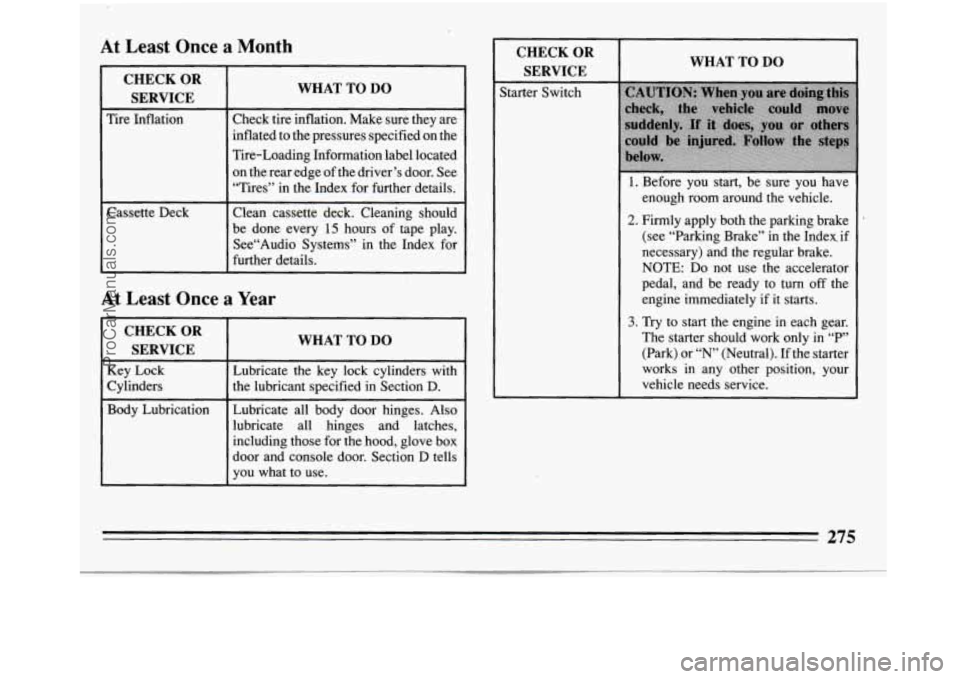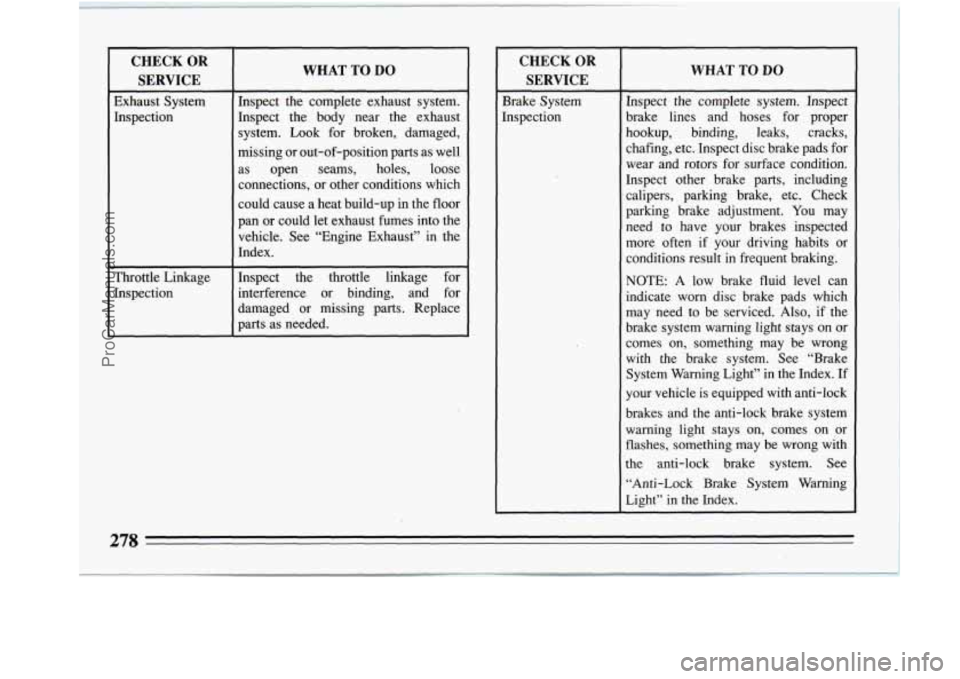Page 269 of 308
Selecting the Right Schedule
First you’ll need to decide which of the two schedules is
right for your vehicle. Here’s how to decide which
schedule to follow:
Schedule I
Is any one of these true for your vehicle?
Most trips are less than 4 miles (6 km).
Most trips are less than 10 miles (16 km) when
outside temperatures are below freezing.
0 The engine is at low speed most of the time (as in
0 You operate your vehicle in dusty areas.
door-to-door delivery,
or in stop-and-go traffic).
0 You tow a trailer.
If any one (or more) of these is true for your driving,
follow Schedule
I.
Schedule I1
Follow Schedule I1 only if none of the above conditions
is true.
267
ProCarManuals.com
Page 270 of 308
Scheduled Maintenance Services Schedule I
Follow Schedule I if your car is MAINLY driven under one or more of the following conditions:
0 When most trips are less than 4 miles (6 kilometers).
0 When most trips are less than 10 miles (16 kilometers) and outside temperatures remain below freezing.
0 When most trips include extended idling and/or frequent low-speed operation as in stop-and-go traffic.
0 Towing a trailer."? '
0 When operating in dusty areas.
I
Schedule I should also be followed if the car is used for delivery service, police, taxi or other commercial applications.
TO BE SERVICED
(See Explanation of
Scheduled Maintenance
Services Following Schedules
I and 11)
Item No.
1. Engine Oil & Oil Filter
Change"
2. Chassis Lubrication
3. Tire & Wheel Inspection &
Rotation
4. Engine Accessory Drive
Belt(s) Inspection*
5. Cooling System Service*
268
ProCarManuals.com
Page 272 of 308
Scheduled Maintenance Services Schedule I1
I Follow Schedule II ONLY if none of the driving conditions specified in Schedule I apply. I
TO BE SERVICED
(See Explanation of
Scheduled Maintenance
Services Following
Schedules
I and IIj
Item No.
1. Engine Oil Change*
Oil Filter Change*
2. Chassis Lubrication ,_ . .
I 3. Tire & Wheel Inspection & Rotation
I MILES /OOO)
WHEN TO PERFORM
Miles (kilometers) or ,Months, Whichever
I Occurs First
12.5
Every 7 500 mi. (12 500 km) or 12 mos. a
~ At first and then every other oil change a
1 Every 7 500 mi. (12 500 km) or 12 mos. 0
I
At 7 500 mi. (12 500 km) and then every
15 000 mi. (25 000 km) or as necessary
4. Engine Accessory Drive Belt(s) Inspection*
5. Cooling System Service* Every 30
000 mi. (50 000 km) or 24 mos.
KILOMETERS (000)
270
ProCarManuals.com
Page 274 of 308

Explanation of Scheduled Maintenance
Services
Below are explanations of the services listed in Schedule
I and Schedule 11.
The proper fluids and lubricants to use are listed
in
Section D. Make sure whoever services your vehicle uses
these. All
parts should be replaced and all necessary
repairs done before you or anyone else drives the vehicle.
NOTE: To determine your engine’s displacement and
code, see “Engine Identification”
in the Index.
1.
Engine Oil and Filter Change* -- Always use SH or
SG Energy Conserving I1 oils of proper viscosity. The
“SH” or “SG” designation may be shown alone or in
combination with others, such as “SH/CD,” “SH, SG,
CD,” “SG/CD” etc.
To determine the preferred
viscosity for your vehicle’s engine (e.g., SAE 5W-30-
or SAE 10W-30), see “Engine Oil” in the Index.
2. Chassis Lubrication -- Lubricate the transaxle shift
linkage, parking brake cable guides, underbody
contact points and linkage. If your vehicle is
equipped with grease fittings, lubricate the
suspension and steering linkage. 3.
4.
5.
Tire
and Wheel Rotation and Inspection -- For
proper wear and maximum tire life, rotate your tires
following the instructions
in this manual. See “Tires,
Inspection
& Rotation” in the Index. Check the tires
for uneven wear or damage. If you see irregular or
premature wear, check the wheel alignment. Check
for damaged wheels also.
Engine Accessory Drive Belt(s) Inspection -- Inspect
the belt(s) for cracks, fraying, wear and proper tension.
Replace as needed. (Belts can have small cracks
in
individual ribs without affecting performance).
Cooling System Service* -- Drain, flush and refill
the system
with new or approved recycled coolant
conforming to GM Specification
1825M. Keep
coolant at the proper mixture as specified. See
“Coolant”
in the Index. This provides proper freeze
protection, corrosion inhibitor level and engine
operating temperature.
Inspect hoses and replace if they are cracked, swollen
or deteriorated. Tighten screw-type hose clamps.
Clean the outside of the radiator and air conditioning
condenser. Wash the pressure cap and neck.
272
ProCarManuals.com
Page 276 of 308

Section B: Owner Checks and
Services
Listed below are owner checks and services which
should be performed at the intervals specified to help
ensure the safety, dependability and emission control
performance
of your vehicle.
Be sure any necessary repairs are completed at once.
Whenever any fluids or lubricants are added to your
vehicle, make sure they are
the proper ones, as shown in
Section
D.
At Each Fuel Fill
(It is important for you or a service station attendant
to perform these underhood checks at each fuel fill.)
CHECK OR
I SERVICE
Engine Oil Level
Level
Level
WHAT TO DO
Check the engine oil level and add the
proper oil
if necessary. See “Engine
Oil” in the Index for further details.
Check the engine coolant level and add
the proper coolant
mix if necessary. See
“Coolant”
in the Index for further
details.
Check the windshield washer fluid
level
in the windshield washer tank and
add the proper fluid
if necessary. See
“Windshield Washer Fluid” in the
Index for further details.
0
274
ProCarManuals.com
Page 277 of 308

At Least Once a Month
CHECK OR
SERVICE
Tire Inflation
Cassette Deck
WHAT TO DO
Check tire inflation. Make sure they are
inflated to the pressures specified on the
Tire-Loading Information label located
on the rear edge of the driver’s door. See
“Tires” in the Index for further details.
Clean cassette deck. Cleaning should
be done every
15 hours of tape play.
See“Audio Systems” in the Index for
further details.
At Least Once a Year
CHECK OR
SERVICE
Key Lock
Cylinders
Body Lubrication
WHAT TO DO
Lubricate the key lock cylinders with
the lubricant specified in Section D.
Lubricate all body door hinges. Also
lubricate all hinges and latches,
including those for the hood, glove box
door and console door. Section
D tells
you what to use.
WHAT TO DO
1. Before you start, be sure you have
enough room around the vehicle.
2. Firmly apply both the parking brake
(see “Parking Brake” in the Index. if
necessary) and the regular brake.
NOTE: Do not use the accelerator
pedal, and be ready to turn
off the
engine immediately if
it starts.
3. Try to start the engine in each gear.
The starter should work only in
“P”
(Park) or “N’ (Neutral). If the starter
works in any other position, your
vehicle needs service.
275
ProCarManuals.com
Page 278 of 308
CHECK OR
SERVICE WHAT TO DO
Steering
Column
in each shift lever position.
brake set, try
to turn the key to “LOCK”
Lock While
parked, and with the parking
0 The key should turn to “LOCK”
only when the shift lever is
in “P”
(Park).
The key should come out only in
“LOCK.”
CHECK OR
SERVICE
Parking Brake and
Automatic
Transaxle
“p’
(Park) Mechanism
Check
WHAT TO DO
Make sure there is room in front -of
your vehicle in case it begins to rolL
Park on a fairly steep hill, with the
vehicle facing downhill. Keeping your
foot on the regular brake, set the
parking brake.
0 To check the parking brake: With
the engine running and the
transaxle
in “N’ (Neutral), slowly
remove foot pressure from the
regular brake pedal.
Do this until
the vehicle
is held by the parking
brake only.
0 To check the “P” (Park)
mechanism’s holding ability: Shift
to
“P” (Park). Then release all
brakes.
276
ProCarManuals.com
Page 280 of 308

CHECK OR
SERVICE
Exhaust System
Inspection
Throttle Linkage
Inspection
WHAT TO DO
Inspect the complete exhaust system.
Inspect the body near the exhaust
system. Look for broken, damaged,
missing or out-of-position parts as well
as open seams, holes, loose connections, or other conditions which
could cause a heat build-up in the floor
pan or could let exhaust fumes into the
vehicle. See “Engine Exhaust” in the
Index.
Inspect the throttle linkage for
interference or binding, and
for
damaged or missing parts. Replace
parts as needed.
CHECK OR
SERVICE
Brake System
Inspection
WHAT TO DO
Inspect the complete system. Inspect
brake lines and hoses for proper
hookup, binding, leaks, cracks,
chafing, etc. Inspect disc brake pads for
wear and rotors for surface condition.
Inspect other brake parts, including
calipers, parking brake, etc. Check
parking brake adjustment. You may
need to have your brakes inspected
more often if your driving habits or
conditions result in frequent braking.
NOTE: A low brake fluid level can
indicate worn disc brake pads which
may need to be serviced. Also, if the
brake system warning light stays on or
comes on, something may be wrong
with the brake system. See “Brake
System Warning Light” in the Index.
If
your vehicle is equipped with anti-lock
brakes and the anti-lock brake system
warning light stays on, comes on or
flashes, something may be wrong with
the anti-lock brake system. See
“Anti-Lock Brake System Warning
Light” in the Index.
ProCarManuals.com